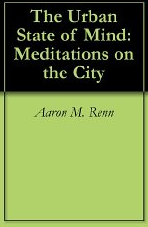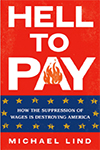NewGeography.com blogs
by Anonymous 03/31/2013
Here we go again! Another ranking of the “best” places to live. I wonder how many of those there are. They just pop up on your computer screen like unwanted ads. Perhaps there are so many “best” cities rankings that at some point most cities end up winning or being in the top 10. Mayors and chambers of commerce know it, just like car companies. If you don’t win the top prize you will simply pick a category and exploit it to death to sell your product. It could be safety, trunk size, fuel efficiency, resale value. In the case of cities, it can be average house price, commuting time, unemployment rate, safety and the pièce de resistance, the vaguest criteria of all, the one that makes rankings such subjective tool: amenities.
What does it mean for MoneySense to be the best? A look at the methodology shows that the criteria are quite typical of most rankings: crime, amenities, commuting, heath, housing etc. Also, the number of points given to each criterion varies from one to another and are totally based on the mood of those who design the ranking. If you think that dry weather is important then you will give it more points. If you dislike bike paths you give it less point. If professional sport teams seem unimportant, you simply don’t use it as a criterion.
One big mistake that those guys do is to mess up distinctions between metropolitan areas and suburbs. Too often, they only include the boundaries of municipalities and break up larger cities into pieces even though they are really parts of greater metropolitan areas. For example, The Greater Toronto Area (GTA) has close to 6 million residents. The Municipality (or City) of Toronto has about 2.5 million people. Mississauga, a populous suburb of the GTA, but has its own place in the very same ranking. How can this be? This is major flaw, a very common one.
So let’s take look at the ranking. We indicate when a city was part of a Census Metropolitan area):
- Calgary, Alberta
- St. Albert, Alberta ( a suburb of the Census Metropolitan Area of Edmonton)
- Burlington, Ontario (a suburb of the Census Metropolitan Are of Toronto)
- Strathcona County, Alberta ( a suburb of the Census Metropolitan Area of Edmonton)
- Oakville, Ontario (a suburb of the Census Metropolitan Are of Toronto)
- Ottawa, Ontario (Since all suburbs of Ottawa has been amalgamated it couldn’t be broken down like Edmonton or Toronto)
- Saanich, British Columbia ( a suburb of the Census Metropolitan Area of Victoria)
- Lacombe, Alberta ( a suburb of the Census Metropolitan Area of Edmonton)
- Lethbridge, Alberta
- Newmarket, Ontario (a suburb of the Census Metropolitan Are of Toronto)
It would be hard to end up with a more flawed ranking. There is a mix of small cities (Lethbridge), the mid-size city of Ottawa, with suburbs that have been amalgamated into one unified City of Ottawa, without taking account that the Census Metropolitan Area includes the City of Gatineau, across the Ottawa River, in the Province of Québec. It is simply impossible to judge a suburb or a city that is part of a metropolitan area and ignore the fact that its amenities, transportation system, jobs, highways etc. are all linked. How would Mississauga’s economy perform if it wasn’t of Toronto, or its airport, (located in Mississauga!)? How would Ottawa do if they didn’t have its pool Gatineau and its pool of 75,000 civil servants living in its more affordable houses, commuting by across the Ottawa River by one of its 5 bridges?
I am not pro-gentrification nor a big fan of downtown living, at least not until my kids will live at home. I myself live in an Ontario suburb of Ottawa, while commuting by train to Montreal a few times a month. However, I am fully aware that my suburb would not exist if not for downtown Ottawa. When 75% of the labour force living in my suburb commutes to downtown Ottawa each day to go to work, if the city had not been amalgamated in 2000, I would have laughed at any ranking that would have considered my suburb as a stand- alone city.
Please guys, you do not rank cities like you rank sports teams.
The Province in Vancouver reports (in "15% of downtown Vancouver condos sit empty, turning areas into ghost towns: Study") that "much of the downtown core is starting to look like B.C.’s ghost towns — with apartments languishing empty, businesses closing down and residents not feeling the sense of community they bought into." The study, by University of British Columbia (UBC) planning professor Andy Yan, indicates that the problem is most pronounced outside the long-established high-rise district of the West End. He notes that in Coal Harbour, well located adjacent to the downtown area along Burrard Inlet, approximately 25% of the condominium units are unoccupied.
UBC economics professor Tour Somerville suggests that the number may even be higher, at 65% vacant, including both unsold units and units that have been purchased but not occupied by their owners. Vancouver has had an unusual amount of investment from mainland China, especially as that nation has substantially limited the purchase of condominium units for investment purposes.
Reporter Mike Reptis of The Province notes the difficulties for businesses in the area, indicating that "it’s a problem to local small business owners and residents — especially in Coal Harbour — who have bought into the neighbourhood expecting more of a community, and more business."
A long time convenience store manager complained that “foot traffic has slowed" and "local people can’t afford (to live here)," concluding that "small grocery stores are closing up" and "A lot of small companies are closing up.”
Frustrated young children confined in the small apartments proliferating in New South Wales are naturally inquisitive and incapable of judging risks. They climb onto window sills or balustrades to fall onto concrete many metres below.
The results have been appalling. In Sydney during the period 1998 to 2008 169 children have fallen to serious injury or death, and, as the proportion of apartments increase, so do these tragic incidents, of which there is now one a week.
Apartments are especially unsuitable for bringing up very young children. Research reveals that there are poor health and parenting outcomes. Crawling and walking is stymied due to space problems with children having little access to areas for meaningful activity. There is a lack of safe active play space outside the home. Parks and other public open space offer poor security due to the use of these areas by local youth gangs and the socially dysfunctional.
Over the past decade, the goal of the New South Wales Government has been that more than half of the population of NSW be squeezed into apartments by the year 2030. These high-density policies have placed a restrictive growth boundary around Sydney, and have been enforced by stripping away the planning powers of those local authorities that dared to offer any resistance.
This draconian approach is despite the fact that the vast majority of Australians prefer living in free-standing homes rather than in apartments. Half of apartment-dwellers would rather live in a house with a garden.
The government has been creating a child-hostile city and a child-hostile city is a disaster for the future.
The Westmead Children’s Hospital in Sydney formed a working party in 2009 in response to the growing number of child tragedies. As a result the NSW Government has now belatedly announced that window safety locks that restrict the degree to which windows can open will be mandatory for new apartments.
But is locking children into apartments and restricting fresh air a good solution? Surely a much better resolution is for the high-density policies to be unambiguously abandoned. Housing that the vast majority of people want should be readily available – that is family friendly single-residential housing with a safe backyard for children’s recreation.
There is some good news for young children, namely the recent announcement by the New South Wales Government of a proposed modified Metropolitan Strategy with the Minister of Planning saying “We’re trying to be less constrictive and restrictive and what we’re saying is the market place should have far more of a say in what the mix of housing is and where it will be.” Might the long-suffering families in Sydney and their young children hope that the iron grip of the high-density policies of the last two decades could be weakening at last?
The new Metropolitan Strategy announcement may indicate a faint light at the end of the tunnel. One hopes this will not be a mere will-of-the-wisp, but that this glimmer will brighten into a beam that will consign urban containment policies to the dustbin of history - and prevent the ongoing falling deaths of some of our most vulnerable kids.
In an article entitled "Portland area's college-educated workers depress metro earning power by choosing low-paying fields, shorter hours," The Oregonian's Betsy Hammond reports on a new study decrying the less than robust economic impact of Portland's younger college graduates, especially males. According to Hammond, " the Portland metro area's young college-educated white men are slackers when it comes to logging hours on the job, and that's one reason people here collectively earn $2.8 billion less a year than the national average." The report is characterized as finding that "Portlanders tend to choose majors, careers and work hours that lead to low pay."
The report, "Higher Education & Regional Prosperity; The Story Behind Portland-Metro's Income Decline," was commissioned by the Value of Jobs Coalition. It documents a "startling decline in per capita income relative to the US" metropolitan average. Since 1997, metropolitan Portland's per capita income has fallen from 5% above the national metropolitan average to 5% below.
The report indicates that "the biggest driver of this trend is our college educated workers, who work less and earn less, creating a significant income gap," though cautiously notes that it is not clear whether” the lower hours and earnings are the result of a lack of higher-paying/time-intensive jobs available or the result "life style choice(s)" to not work in higher-paying jobs."
The report found the largest differences compared to other metropolitan areas to be among white males from 25 to 39 years old. The differences with the rest of the country were substantially less among older white males.
Metropolitan America continues to expand. The new Office of Management and Budget metropolitan area definitions, based upon the 2010 census indicate that the counties composing the 52 metropolitan areas with more than 1 million population increased by 1.65 million from the previous definition. This includes more than 1.4 million new residents in the previous 51 major metropolitan areas and more than 200,000 in Grand Rapids, which has become the nation's 52nd metropolitan area with more than 1 million population.
The fastest growers due to the addition of counties were New York, Charlotte, Grand Rapids, and Indianapolis. New York had a 670,000 increase in its metropolitan population, resulting from the addition of Dutchess and Orange counties. New counties also increased the population of the Charlotte metropolitan area by 459,000, the Grand Rapids metropolitan area by 215,000 and Indianapolis by 132,000. The largest percentage gains were in Grand Rapids (28%) and Charlotte (26%).
Ten metropolitan areas had population increases under 100,000 from expansion of the metropolitan area definitions.
For the most part, the major metropolitan area county components were unchanged, with 31 having the same boundaries as under the previous definition. Six metropolitan areas were reduced in geographic size.
The changes in population for 2000 based upon the new metropolitan area definitions are indicated in the table. The components of metropolitan areas are determined by commuting patterns to urban areas (not to the historical core municipalities).
| Effect of New Metropolitan Area Geographic Definition on Population: 2010 |
| Population Change Rank |
Metropolitan Area |
Old Definition |
New Definition (2013) |
Change |
% Change |
| 12 |
Atlanta, GA |
5,268,860 |
5,286,728 |
17,868 |
0.3% |
| 15 |
Austin, TX |
1,716,289 |
1,716,289 |
0 |
0.0% |
| 15 |
Baltimore, MD |
2,710,489 |
2,710,489 |
0 |
0.0% |
| 15 |
Birmingham, AL |
1,128,047 |
1,128,047 |
0 |
0.0% |
| 15 |
Boston, MA-NH |
4,552,402 |
4,552,402 |
0 |
0.0% |
| 15 |
Buffalo, NY |
1,135,509 |
1,135,509 |
0 |
0.0% |
| 2 |
Charlotte, NC-SC |
1,758,038 |
2,217,012 |
458,974 |
26.1% |
| 15 |
Chicago, IL-IN-WI |
9,461,105 |
9,461,105 |
0 |
0.0% |
| 46 |
Cincinnati, OH-KY-IN |
2,130,151 |
2,114,580 |
(15,571) |
-0.7% |
| 15 |
Cleveland, OH |
2,077,240 |
2,077,240 |
0 |
0.0% |
| 7 |
Columbus, OH |
1,836,536 |
1,901,974 |
65,438 |
3.6% |
| 8 |
Dallas-Fort Worth, TX |
6,371,773 |
6,426,214 |
54,441 |
0.9% |
| 15 |
Denver, CO |
2,543,482 |
2,543,482 |
0 |
0.0% |
| 15 |
Detroit, MI |
4,296,250 |
4,296,250 |
0 |
0.0% |
| 3 |
Grand Rapids, MI |
774,160 |
988,938 |
214,778 |
27.7% |
| 15 |
Hartford, CT |
1,212,381 |
1,212,381 |
0 |
0.0% |
| 49 |
Houston, TX |
5,946,800 |
5,920,416 |
(26,384) |
-0.4% |
| 4 |
Indianapolis. IN |
1,756,241 |
1,887,877 |
131,636 |
7.5% |
| 15 |
Jacksonville, FL |
1,345,596 |
1,345,596 |
0 |
0.0% |
| 48 |
Kansas City, MO-KS |
2,035,334 |
2,009,342 |
(25,992) |
-1.3% |
| 15 |
Las Vegas, NV |
1,951,269 |
1,951,269 |
0 |
0.0% |
| 15 |
Los Angeles, CA |
12,828,837 |
12,828,837 |
0 |
0.0% |
| 51 |
Louisville, KY-IN |
1,283,566 |
1,235,708 |
(47,858) |
-3.7% |
| 13 |
Memphis, TN-MS-AR |
1,316,100 |
1,324,829 |
8,729 |
0.7% |
| 15 |
Miami, FL |
5,564,635 |
5,564,635 |
0 |
0.0% |
| 15 |
Milwaukee,WI |
1,555,908 |
1,555,908 |
0 |
0.0% |
| 6 |
Minneapolis-St. Paul, MN-WI |
3,279,833 |
3,348,859 |
69,026 |
2.1% |
| 5 |
Nashville, TN |
1,589,934 |
1,670,890 |
80,956 |
5.1% |
| 11 |
New Orleans. LA |
1,167,764 |
1,189,866 |
22,102 |
1.9% |
| 1 |
New York, NY-NJ-PA |
18,897,109 |
19,567,410 |
670,301 |
3.5% |
| 15 |
Oklahoma City, OK |
1,252,987 |
1,252,987 |
0 |
0.0% |
| 15 |
Orlando, FL |
2,134,411 |
2,134,411 |
0 |
0.0% |
| 15 |
Philadelphia, PA-NJ-DE-MD |
5,965,343 |
5,965,343 |
0 |
0.0% |
| 15 |
Phoenix, AZ |
4,192,887 |
4,192,887 |
0 |
0.0% |
| 15 |
Pittsburgh, PA |
2,356,285 |
2,356,285 |
0 |
0.0% |
| 15 |
Portland, OR-WA |
2,226,009 |
2,226,009 |
0 |
0.0% |
| 15 |
Providence, RI-MA |
1,600,852 |
1,600,852 |
0 |
0.0% |
| 15 |
Raleigh, NC |
1,130,490 |
1,130,490 |
0 |
0.0% |
| 52 |
Richmond, VA |
1,258,251 |
1,208,101 |
(50,150) |
-4.0% |
| 15 |
Riverside-San Bernardino, CA |
4,224,851 |
4,224,851 |
0 |
0.0% |
| 10 |
Rochester, NY |
1,054,323 |
1,079,671 |
25,348 |
2.4% |
| 15 |
Sacramento, CA |
2,149,127 |
2,149,127 |
0 |
0.0% |
| 47 |
St. Louis,, MO-IL |
2,812,896 |
2,787,701 |
(25,195) |
-0.9% |
| 50 |
Salt Lake City, UT |
1,124,197 |
1,087,873 |
(36,324) |
-3.2% |
| 15 |
San Antonio, TX |
2,142,508 |
2,142,508 |
0 |
0.0% |
| 15 |
San Diego, CA |
3,095,313 |
3,095,313 |
0 |
0.0% |
| 15 |
San Francisco-Oakland, CA |
4,335,391 |
4,335,391 |
0 |
0.0% |
| 15 |
San Jose, CA |
1,836,911 |
1,836,911 |
0 |
0.0% |
| 15 |
Seattle, WA |
3,439,809 |
3,439,809 |
0 |
0.0% |
| 15 |
Tampa-St. Petersburg, FL |
2,783,243 |
2,783,243 |
0 |
0.0% |
| 14 |
Virginia Beach-Norfolk, VA-NC |
1,671,683 |
1,676,822 |
5,139 |
0.3% |
| 9 |
Washington, DC-VA-MD-WV |
5,582,170 |
5,636,232 |
54,062 |
1.0% |
|
|
|
|
|
|
|
Total |
167,861,575 |
169,512,899 |
1,651,324 |
1.0% |
|












